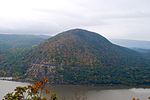Breakneck Brook

Breakneck Brook, sometimes Breakneck Valley Brook, is a 1.7-mile-long (2.8 km) tributary of the Hudson River located entirely in the Putnam County town of Philipstown, New York, United States. It rises at Surprise Lake and flows southwest towards the Hudson from there, mostly through Hudson Highlands State Park. The name comes from Breakneck Ridge to its north. Two of the park's hiking trails parallel Breakneck Brook for much of its course. Most of the land the brook flows through was once part of the estate of Edward G. Cornish, chairman of the National Lead Company in the early 20th century. He established a large dairy farm on the property, and ruins of structures built for that purpose, including a large cistern, are still visible along the stream.
Excerpt from the Wikipedia article Breakneck Brook (License: CC BY-SA 3.0, Authors, Images).Breakneck Brook
Bear Mountain-Beacon Highway, Town of Philipstown
Geographical coordinates (GPS) Address Nearby Places Show on map
Geographical coordinates (GPS)
| Latitude | Longitude |
|---|---|
| N 41.438333333333 ° | E -73.973611111111 ° |
Address
Bear Mountain-Beacon Highway 3002
10516 Town of Philipstown
New York, United States
Open on Google Maps










